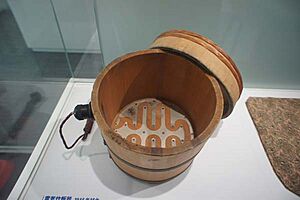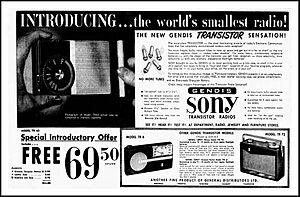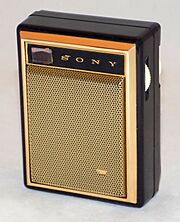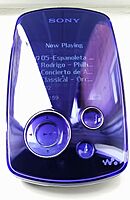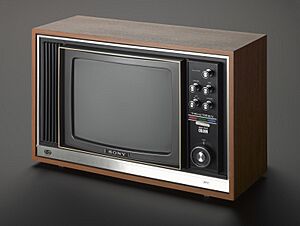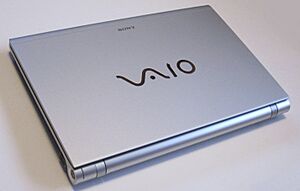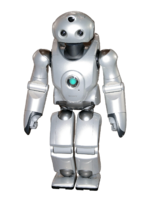Sony facts for kids

Logo used since 1973
|
|
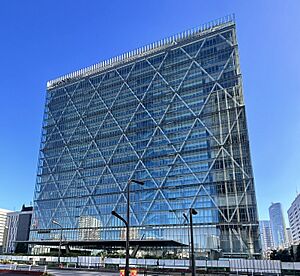
Headquarters in Minato, Tokyo
|
|
|
Native name
|
ソニーグループ株式会社
|
|---|---|
|
Romanized name
|
Sonī Gurūpu Kabushiki Kaisha |
|
Formerly
|
|
| Public | |
| Traded as | |
| Industry | Conglomerate |
| Founded | 7 May 1946 Nihonbashi, Chūō, Tokyo, Japan |
| Founders | |
| Headquarters | Sony City,
Minato, Tokyo
,
Japan
|
|
Area served
|
Worldwide |
|
Key people
|
|
| Products |
|
| Services |
|
| Revenue | (US$90.14 billion) (2024) |
|
Operating income
|
(US$10.09 billion) (2024) |
(US$6.69 billion) (2024) |
|
| Total assets | |
| Total equity | (US$56.26 billion) (2024) |
|
Number of employees
|
113,000 (2023) |
| Divisions |
|
| Subsidiaries | List of assets owned by Sony |
| Footnotes / references Financials as of 31 March 2021[update]. References: |
|
Sony Group Corporation is a big Japanese company. It's like a giant group of businesses, with its main office in Minato, Tokyo, Japan. The Sony Group includes many different parts, such as:
- Sony Corporation (which makes electronics)
- Sony Semiconductor Solutions (which makes parts for cameras and other devices)
- Sony Entertainment (which includes Sony Pictures for movies and Sony Music Group for music)
- Sony Interactive Entertainment (which makes video games)
- Sony Financial Group (which offers financial services)
Sony was started in 1946 by Masaru Ibuka and Akio Morita. Back then, it was called Tokyo Tsushin Kogyo K.K. . In 1958, the company changed its name to Sony Corporation.
At first, Sony focused on electronics. They became famous for products like the TR-55 transistor radio and the CV-2000 home video tape recorder. These products helped Japan's economy grow after World War II. After Ibuka retired in the 1970s, Morita led Sony until 1994. During this time, Sony became a global brand known for new ideas in consumer electronics. Some of their most famous products were the Trinitron color television, the Walkman portable music player, and the compact disc (which they helped create).
Sony also expanded into other areas. They bought Columbia Records in 1988 and Columbia Pictures in 1989. They also entered the home video game market by launching the PlayStation in 1994. In Japan, they even started a financial services business. In 2021, the company changed its name to Sony Group Corporation. This meant it became a "holding company," which is a company that owns other companies. Its electronics business continued under the name Sony Corporation.
As of 2020[update], Sony makes more than half of the world's image sensors. This makes them the biggest maker of these parts. They are also the second largest camera maker and the third largest television maker by sales.
Contents
History of Sony
How Sony Started
Sony began after World War II. In 1946, Masaru Ibuka opened an electronics shop in a department store in Nihonbashi, Tokyo. The company started with a small amount of money and only eight employees. On May 7, 1946, Ibuka and Akio Morita created a company called Tokyo Telecommunications Engineering Corporation. This company built Japan's first tape recorder, called the Type-G. In 1958, the company changed its name to "Sony."
Choosing the Name "Sony"
The founders, Morita and Ibuka, wanted their company to be successful worldwide. They needed a short and easy-to-remember name for their products. They thought about using their initials, TTK, but another railway company already used that. They also tried "Totsuko" in Japan, but Americans found it hard to say. Another idea was "Tokyo Teletech," but an American company already used that name.
The name "Sony" was chosen by mixing two words. One was the Latin word "sonus", which means sound. The other was "sonny", a slang term for a young boy in 1950s America. In Japan, "sonny boys" meant smart and stylish young men, which Morita and Ibuka thought they were.
The first product with the Sony name was the TR-55 transistor radio in 1955. But the company itself didn't officially change its name to Sony until January 1958. It was very unusual for a Japanese company to use Roman letters for its name back then. Some people, including their main bank, wanted a name like Sony Electronic Industries. But Akio Morita insisted on "Sony" because he didn't want the company name to be limited to just one type of business.
Becoming a Global Company
Sony's TR-63 radio helped them enter the U.S. market and started the new industry of small electronics for everyday people. By the mid-1950s, American teenagers were buying many portable transistor radios. This helped the new industry grow from 100,000 units in 1955 to 5 million by 1968.
Akio Morita started Sony Corporation of America in 1960. He noticed that American workers often moved between companies, which was rare in Japan. When he returned, he encouraged experienced Japanese workers to join Sony. This helped Sony grow and inspired other Japanese companies. Sony also played a big part in Japan becoming a strong exporter in the 1960s, 70s, and 80s. They were known for high-quality products and could charge higher prices.
In 1971, Masaru Ibuka passed the role of president to Akio Morita. Sony started a life insurance company in 1979, adding to its many businesses. In the early 1980s, during a worldwide economic slowdown, electronics sales dropped. Sony had to lower prices, and their profits fell a lot. Some people thought Sony's best days were over.
Around that time, Norio Ohga became president. He supported the creation of the compact disc (CD) in the 1970s and 1980s, and the PlayStation in the early 1990s. Ohga also bought CBS Records in 1988 and Columbia Pictures in 1989. This greatly expanded Sony's presence in music and movies. Ohga became the chief executive officer in 1989.
Sony continued to expand into new businesses. They wanted to connect movies, music, and digital electronics using the internet. However, this expansion was not always profitable. In 2005, Howard Stringer became the chief executive officer. He was the first non-Japanese person to lead a major Japanese electronics company. Stringer helped improve Sony's movie businesses, like making successful films such as Spider-Man. He also cut 9,000 jobs and wanted to sell off less important businesses to focus on electronics. He also tried to make different parts of Sony work together better. In 2009, Sony introduced the slogan "make.believe" to unite its global brand.
Despite some successes, Sony faced challenges in the late 2000s. In 2012, Kazuo Hirai became president and CEO. He started a company-wide plan called "One Sony" to help Sony recover from financial losses. Hirai focused on three main areas for Sony's electronics: imaging technology, gaming, and mobile technology. He also worked to reduce losses from the television business.
In February 2014, Sony sold its Vaio PC business. They also made their TV division a separate company to help it improve. Later that month, they closed 20 stores. In April, they sold some shares in Square Enix, a game company. In May 2014, Sony partnered with Shanghai Oriental Pearl Group to make and sell PlayStation consoles and games in China. In 2015, Sony bought Toshiba's image sensor business.
In 2017, Sony sold its lithium-ion battery business. In 2019, Sony combined its mobile, TV, and camera businesses. On April 1, 2020, Sony Electronics Corporation was created to manage its electronics and IT businesses. On May 19, 2020, the company announced it would change its name to Sony Group Corporation on April 1, 2021. Sony Electronics Corporation was then renamed Sony Corporation.
On April 1, 2021, Sony Corporation officially became Sony Group Corporation. On the same day, several Sony electronics companies merged into the new Sony Corporation.
Sony's Technologies and Formats
Sony has often created its own standards for new recording and storage technologies. For example, they worked with Philips to create the Digital Compact Cassette standard. Sony has also introduced popular formats like the 3.5-inch floppy disk, compact disc, and Blu-ray disc.
Video Recording Technologies
Sony introduced U-matic, the first videocassette format, in 1971. It was too expensive for home use. Then, in 1975, they launched Betamax. Sony was part of a "videotape format war" in the early 1980s, competing against the VHS format from JVC. VHS eventually became the most popular format for home video recorders.
Betamax is no longer used today. However, Sony's professional video format, Betacam, which came from Betamax, was used until 2016. In 1985, Sony launched their Handycam cameras and the Video8 format. These became popular for home camcorders. In 1987, Sony launched the 4 mm DAT or Digital Audio Tape for digital audio.
Screen Display Technologies
Sony had a special patent for its Trinitron screen technology until 1996. In 2004, Sony introduced Triluminos Display, a technology to make colors look better. It was used in the first LED-backlit LCD televisions and other Sony products like computer monitors, laptops, and smartphones. In 2013, Sony improved this technology by using quantum dots, which was a first for commercial products. In 2012, Sony showed a new type of LED screen called the Crystal LED Display.
Audio Recording Technologies
Sony used the Compact Cassette format in many of its tape recorders and players, including the Walkman. The Walkman was the world's first portable music player, released in 1979. It changed how people listened to music, allowing them to carry music with them. The Walkman brand later included portable digital audio and video players. For CD players, Sony used the Discman brand until the late 1990s.
In 1999, Sony introduced its first portable digital audio players. Sony continues to make Walkman digital audio players, but they haven't had the same huge impact as the original cassette Walkman. Sony is a big maker of audio products and a leader in active noise control technology.
Audio Encoding Technologies
In 1993, Sony created SDDS for movie theaters. This format had eight audio channels, more than the six channels in Dolby Digital 5.1 at the time. However, SDDS was not as widely used as DTS and Dolby Digital in the movie industry. Sony never made a home version of SDDS.
Sony and Philips also worked together on the Sony-Philips digital interface format (S/PDIF) and the high-quality audio system SACD. Neither of these became very popular with the general public. CDs were preferred by most people until the early 2000s when the iPod and music streaming became available.
In 2015, Sony introduced LDAC, a special audio technology that lets you stream high-quality audio over Bluetooth. Sony also made it part of Android 8.0 "Oreo", so other companies could use it in their Android devices.
Optical Storage Technologies
Sony showed an optical digital audio disc in 1977. They then worked with Philips to create a worldwide standard. In 1983, they both announced the Compact Disc (CD). In 1984, Sony launched the Discman series, which were portable CD players. Sony also created write-once optical discs and magneto-optical discs for storing data in the 1980s.
In the early 1990s, two new high-density disc standards were being developed: MultiMedia Compact Disc (MMCD) by Philips and Sony, and Super Density Disc (SD) by Toshiba and others. Philips and Sony decided to use Toshiba's SD format with a small change. This new combined format was called DVD and was released in 1997.
Sony was a main developer of the Blu-ray optical disc format. Blu-ray became the standard for high-definition movies after a "format war" with Toshiba's HD DVD. The first Blu-ray players came out in 2006.
Disk Storage Technologies
In 1983, Sony introduced 3.5-inch floppy disks. These became very popular and replaced older, larger floppy disks. However, 3.5-inch floppy disks eventually became old-fashioned as new storage methods appeared. Sony stopped making them in 2010.
Sony still works with IBM on magnetic tape storage technologies. They are one of only two companies that make Linear Tape-Open (LTO) cartridges.
Flash Memory Technologies
In 1998, Sony launched the Memory Stick format for its digital cameras and portable music players. However, Secure Digital cards (SD) became much more popular. Sony later made updates to the Memory Stick format, like Memory Stick Duo. They also sell USB flash drives called Micro Vault.
Communication Technologies
Sony introduced FeliCa, a contactless smart card technology used for things like contactless payment. This came from Sony's work with Philips on near-field communication (NFC). Sony plans to use this technology in train systems across Asia. In 2019, Sony launched ELTRES, its own wireless communication standard for low-power devices.
Video Gaming Technologies
Until 1991, Sony was not very involved in video games. They made parts for other consoles, like the sound chip for Nintendo's Super Famicom. Sony and Nintendo even worked together to create a CD-ROM version of the Super Famicom, called the "Play Station." But in June 1991, Nintendo ended the partnership because they couldn't agree on how to share profits. This made Sony's president, Norio Ohga, very angry. He then told Ken Kutaragi to develop the PlayStation project to compete with Nintendo.
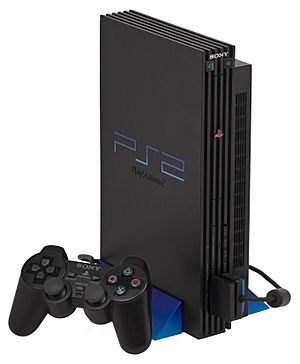
Kutaragi showed a CD-ROM system that could play games with 3D graphics. Ohga decided to continue the project. However, many older Sony executives were against it. So, Kutaragi and his team had to move to Sony Music, a separate company owned by Sony, to keep working on the PlayStation.
Sony's Businesses
Sony is famous for its electronics, but it has many different types of businesses. In the past, it was called a "corporate octopus" because it had so many different ventures, from insurance to cosmetics. Even after selling some businesses like Sony Chemicals and Vaio PCs, Sony still runs many different companies.
As of 2020, Sony has several main business groups:
- Game & Network Services (G&NS)
- Music
- Pictures
- Electronics Products & Solutions (EP&S)
- Imaging & Sensing Solutions (I&SS)
- Financial Services
- Other businesses
Each of these groups usually has smaller companies under it. For example, Columbia Records is part of Sony Music Group.
Electronics Products & Solutions
Sony Corporation is the part of Sony Group that focuses on electronics. It researches, designs, makes, and sells electronic products. Sony Global Manufacturing & Operations Corporation (SGMO) manages Sony's factories in Japan and other countries.
Audio Products
In 1979, Sony released the Walkman, the world's first portable music player. It came with lightweight headphones. The Walkman changed how people listened to music, allowing them to take it anywhere. The Walkman brand later included digital audio and video players, and even some Sony Ericsson mobile phones. For portable CD players, Sony used the Discman brand.
In 1999, Sony introduced its first portable digital audio players. Sony still makes Walkman digital audio players. Sony is a big maker of audio products and a leader in active noise control technology. Sony's high-quality microphones and headphones for professionals are made at Sony/Taiyo Corporation in Japan.
Car Audio
Sony has worked with car companies like Ford and Toyota to provide audio systems for their vehicles. They also make aftermarket car audio products called the Mobile ES series.
Video Products
In 1959, Sony made the TV8-301, the world's first all-transistor television. In 1968, they introduced the Trinitron brand for their color televisions and computer monitors. Sony stopped making Trinitron TVs for most markets in the early 2000s. The last Trinitron TV in the U.S. was discontinued in early 2007. This marked the end of Sony's older analog TVs.
Sony used the LCD WEGA name for its LCD TVs until 2005. Then, they introduced the BRAVIA name. BRAVIA is Sony's brand for high-definition LCD televisions, home cinemas, and projectors. All Sony flat-panel LCD TVs in North America have had the BRAVIA logo since 2005. In 2006, Sony lost its long-held position as the number one TV maker in the world. In 2007, Sony released the Sony XEL-1, the first OLED television. In 2013, Sony showed the first 4K OLED television. As of 2012, Sony was the third-largest TV maker globally.
Since 2011, Sony has been changing its TV business to make it more profitable. They have outsourced the making of display panels to companies like Sharp Corporation and LG Display. In 2017, Sony launched OLED televisions under the BRAVIA brand. Sony has also sold many tapes, discs, recorders, and players for videocassette, DVD, and Blu-ray formats for decades.
Photography and Videography
Sony makes many digital cameras. Their point-and-shoot cameras are called Cyber-shot, while their DSLRs and mirrorless cameras are called Alpha. Sony also makes action cameras and camcorders. Their professional cinema cameras are sold under the CineAlta name.
Sony showed a prototype of the Sony Mavica in 1981 and released it in 1988. The first Cyber-shot camera came out in 1996. Sony entered the market for digital single-lens reflex cameras in 2006 when they bought the camera business of Konica Minolta. Sony renamed these cameras to its Alpha line. Sony is the world's third-largest camera maker, after Canon and Nikon.
In 2010, Sony introduced its first mirrorless interchangeable-lens cameras, the NEX-3 and NEX-5. They also started a new lens system called the E-mount. Later, Sony combined the NEX series into the Alpha series. The α6000 became a very popular mirrorless camera, and Sony became the largest maker of these cameras.
Computing Products
Sony made computers in the 1980s, like the SMC-777 personal computer and MSX home computers. They stopped making computers around 1990. Sony re-entered the computer market in 1996 with the new VAIO brand. VAIO stands for "Video Audio Integrated Operation," and these computers were known for their video and audio features.
In 2006, Sony faced a problem when some of its laptop batteries exploded and caught fire. This led to a very large recall of computer batteries. To join the tablet computer market, Sony launched its Sony Tablet line of Android tablets in 2011. Since 2012, Sony's Android products have been sold under the Xperia brand, which is also used for its smartphones.
On February 4, 2014, Sony announced it would sell its VAIO PC business due to low sales. A Japanese company called Japan Industrial Partners bought the VAIO brand. As of 2018, Sony still owned a small part of the new company. In the 1990s, Sony also made laptop computers for Apple and Dell. The Raspberry Pi Foundation has Sony make its single-board computers at a factory in Wales, UK.
Healthcare and Biotechnology
Sony sees medical, healthcare, and biotechnology as important areas for future growth. In 2010, they bought iCyt Mission Technology, Inc. (now Sony Biotechnology Inc.), which makes flow cytometers. In 2011, they bought Micronics, Inc., which develops diagnostic tools.
In 2012, Sony announced it would buy all shares of So-net Entertainment Corporation, which owns M3, Inc., a company that runs websites for healthcare professionals. On September 28, 2012, Olympus and Sony announced they would create a joint company to develop new surgical endoscopes with 4K resolution and 3D features. This company, Sony Olympus Medical Solutions Inc., was started on April 16, 2013.
Mobility Products
In 2000, Sony was a small player in the mobile phone market. In 2001, Sony partnered with the Swedish company Ericsson to form Sony Ericsson Mobile Communications. Sales were difficult at first, but Sony Ericsson became profitable in 2003. They became known for mobile phones with multimedia features like cameras, which were new at the time. However, they faced strong competition from Apple's iPhone, released in 2007.
From 2008 to 2010, Sony Ericsson cut thousands of jobs during a global economic slowdown. In 2009, Sony Ericsson was the fourth-largest mobile phone maker. By 2010, they had fallen to sixth place. Sony bought Ericsson's share of the company in 2012. Sony Mobile now focuses only on the smartphone market under the Xperia brand. In 2013, Sony made about two percent of the mobile phone market. Sony Mobile's sales peaked in 2014, but have decreased since then.
Robotics
Since the late 1990s, Sony has made many robots for consumers. These include dog-shaped robots called AIBO, a music-playing robot called Rolly, and a humanoid robot called QRIO. Sony stopped working on robotics for 10 years due to financial problems, but they started again in 2016.
In 2015, Sony partnered with a company called ZMP INC. to create Aerosense, which makes drones for surveillance. At the CES 2021 event, Sony showed a drone called Airpeak. It is the smallest drone that can carry a Sony Alpha camera. This marked Sony's entry into the drone business on its own.
Imaging & Sensing Solutions
Sony's history in the semiconductor business goes back to 1954. They were the first Japanese company to sell the transistor, which was invented by Bell Labs. In 1957, Sony employee Leo Esaki invented a tunnel diode, which led to his Nobel prize in Physics in 1973. Sony has been a leader in the charge-coupled device market.
As of 2020, Sony is the world's largest maker of CMOS image sensors. These chips are used in digital cameras, tablets, smartphones, drones, and self-driving cars. Sony Semiconductor Solutions designs and sells many semiconductors and electronic parts. These include image sensors, image processors, laser diodes, and new types of memory storage and displays.
Game & Network Services
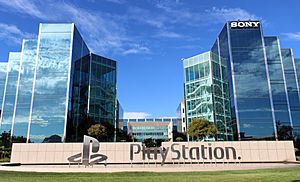
Sony Interactive Entertainment (formerly Sony Computer Entertainment) is famous for making the popular PlayStation consoles. This business grew out of a failed partnership with Nintendo. Nintendo had asked Sony to develop a CD-ROM add-on for its Super Nintendo Entertainment System. In 1991, Sony announced this add-on and a console called the "Play Station." However, a disagreement over software licensing caused the partnership to end. Sony then continued the project on its own.
The first PlayStation was launched in 1994. It sold very well, taking 61% of global console sales and ending Nintendo's long lead in the market. Sony then released the PlayStation 2 in 2000, which was even more successful. The PlayStation 2 became the best-selling video game console of all time, selling over 150 million units as of 2011[update].
Sony released the PlayStation 3, a high-definition console, in 2006. It was the first console to use the Blu-ray format. It was more expensive than its competitors, the Xbox 360 and Wii. At first, the PlayStation 3 sold poorly and caused losses for Sony. However, it eventually sold more than the Xbox 360 globally. Sony later introduced the PlayStation Move, an accessory that lets players control games with motion.
Sony entered the portable games market in 2004 with the PlayStation Portable (PSP). The PSP sold well, but it was second to the Nintendo DS. Sony created the Universal Media Disc (UMD) for the PSP. Sony released a version of the PSP without a disc drive, the PSP Go, in 2009. They then released their second portable video game system, PlayStation Vita, in 2011 and 2012. Sony launched its fourth console, the PlayStation 4, on November 15, 2013.
On March 18, 2014, Sony announced its new virtual reality technology called Project Morpheus, later named PlayStation VR, for PlayStation 4. This headset brought VR gaming to the console. PlayStation VR was released worldwide on October 13, 2016.
On March 31, 2019, Sony announced the next PlayStation console. On November 12, 2020, the PlayStation 5 was released in North America, Australia, New Zealand, Japan, South Korea, and Singapore. It launched in Indonesia on January 22, 2021. Sony sold 4.5 million PlayStation 5 consoles in its first fiscal quarter, keeping pace with the PlayStation 2.
Pictures and Music Businesses
Sony Entertainment has two main parts: Sony Pictures Entertainment (for movies and TV) and Sony Music Group (Sony Music Entertainment and Sony Music Publishing for music).
Sony Pictures Entertainment
Sony Pictures Entertainment Inc. (SPE) is Sony's television and film production and distribution company. In 2011, it was the third-largest movie studio. The company has made many famous movie series, including Spider-Man, The Karate Kid, and Men in Black. It also produces popular TV game shows like Jeopardy! and Wheel of Fortune.
Sony entered the TV and film business when it bought Columbia Pictures Entertainment in 1989. Columbia Pictures is now part of the Sony Pictures Motion Picture Group, which also owns TriStar Pictures, Screen Gems, and Sony Pictures Classics. SPE's TV division is called Sony Pictures Television.
For its first few years, Sony Pictures Entertainment did not do very well. In late 2014, Sony Pictures was attacked by hackers before releasing the movie The Interview. In February 2024, Sony made a deal with Disney for Sony Pictures Home Entertainment to handle the release of Disney products on DVD and Blu-ray in Canada and the U.S.
Sony Music Group and SMEJ
Sony Music Entertainment (also known as SME or Sony Music) is one of the largest music companies in the world. It is controlled by Sony Corporation of America, which is Sony's U.S. branch.
In one of its biggest purchases ever, Sony bought CBS Record Group in 1988. This deal also gave Sony rights to Michael Jackson's ATV music catalogue. This purchase led to the creation of Sony Music Entertainment in 1991.
In 1968, Sony and CBS Records had already formed a joint company in Japan called CBS/Sony Records. When Sony bought CBS Records, it also gained full ownership of this Japanese company. In 1988, this company was renamed Sony Music Entertainment Japan (SMEJ). It operates separately from Sony Music and is directly owned by Sony in Japan.
In 2004, Sony partnered with Bertelsmann AG to create Sony BMG. In 2005, Sony BMG faced a problem because its music CDs installed malware on users' computers. In 2007, the company bought Famous Music, gaining rights to music by artists like Eminem. Sony bought out Bertelsmann's share in Sony BMG in 2008, forming a new Sony Music Entertainment.
Besides its record label, Sony has other music businesses. In 1995, Sony combined its music publishing company with Michael Jackson's ATV Music Publishing, forming Sony/ATV Music Publishing. This company became the second largest of its kind. It owns the rights to over 4 million songs, including music by The Beatles, Bob Dylan, Eminem, and Taylor Swift. In 2012, Sony/ATV bought most of EMI Music Publishing, becoming the world's largest music publishing company. In 2018, Sony bought the rest of the shares, making it fully owned by Sony.
Anime Business

Sony entered the Japanese animation, or anime, business in 1995. Its Sony Music Entertainment Japan (SMEJ) division created Aniplex to manage creative productions. Aniplex then founded A-1 Pictures, Sony's first anime studio, ten years later. Sony has grown its position in the anime industry through various partnerships.
Sony's anime businesses are spread across its Pictures and Music groups. SMEJ's related businesses include Aniplex and its studios CloverWorks and A-1 Pictures. Aniplex and U.S.-based Sony Pictures jointly own Crunchyroll, an anime distribution company in the U.S. Since 2022, Crunchyroll has taken over from Funimation, which Sony acquired in 2017.
In December 2020, Funimation announced it would buy AT&T's anime business Crunchyroll. This purchase was completed in August 2021.
Financial Services
Sony Financial Group is a company that holds Sony's financial services businesses. These include Sony Life (life insurance), Sony Assurance, and Sony Bank. This part of Sony was very profitable in 2005.
Other Businesses
Electric Vehicles and Batteries
Sony was involved in making lithium-ion batteries. In 2014, Sony participated in a program for EV charging parking lots. However, the company decided to sell its lithium-ion battery business in 2016.
In 2015, Sony invested in a company called ZMP INC. that works on self-driving cars. In January 2020, Sony showed a concept electric car called Vision-S at the Consumer Electronics Show. It was designed with Magna International. Sony also said it wanted to develop technology for cars, especially for self-driving, sensors, and in-car entertainment.
In 2022, Sony Group and Honda started a joint company called Sony Honda Mobility (SHM) for electric vehicles. They plan to deliver their first electric vehicles by 2026 and sell them online, starting in the United States and Japan. The joint company announced their new "Afeela" brand and its first prototype model at the CES 2023.
Company Information
Ownership of Sony
Sony is a Japanese company listed on the Tokyo Stock Exchange. Its shares are also traded on the New York Stock Exchange. As of March 31, 2023, some of the largest owners of Sony shares include:
- Investment trusts managed by The Master Trust Bank of Japan
- Citibank (for American share holders)
- Investment trusts managed by Japan Trustee Services Bank
- JPMorgan Chase Bank
Business Performance
Sony was very profitable in the 1990s and early 2000s, partly because of the success of its new PlayStation line. However, the company faced financial difficulties in the late 2000s due to things like the Great Recession, more competition for PlayStation, and the 2011 Tōhoku earthquake and tsunami. The company had losses for three years leading up to 2011.
On December 9, 2008, Sony announced it would cut 8,000 jobs and reduce its factories to save money. In April 2012, Sony announced it would cut another 10,000 jobs as part of CEO Kaz Hirai's plan to make the company profitable again. This came after a large loss for the 2012 fiscal year. Sony planned to increase its marketing spending in 2012.
In January 2013, Sony announced it was selling its U.S. headquarters building. On February 6, 2014, Sony said it would cut up to 5,000 jobs as it sold its PC business and focused on mobile and tablets. In November 2018, Sony reported a loss in its mobile phone division, leading to more job cuts and the closure of a factory.
Community Involvement
- EYE SEE project
Sony works with UNICEF on the EYE SEE project. This project holds digital photography workshops for children in many countries, including Argentina, South Africa, and Pakistan. - South Africa Mobile Library Project
Sony helps the South Africa Primary Education Support Initiative (SAPESI) by donating money and children's books to the South Africa Mobile Library Project. - The Sony Canada Charitable Foundation
This foundation supports charities like Make-A-Wish Canada and the United Way of Canada. - Sony Foundation and You Can
After natural disasters in Australia, Sony Music released benefit albums to raise money for the Sony Foundation. "You Can" is the Sony Foundation's program for youth cancer. - Open Planet Ideas Crowdsourcing Project
Sony launched this project with the World Wildlife Fund to get ideas from the public. - Street Football Stadium Project
For the 2014 World Cup in Brazil, Sony partnered with streetfootballworld to create the Street Football Stadium Project. This project supports football-based education programs in communities across Latin America and Brazil. - The Sony Global Relief Fund for COVID-19
During the COVID-19 pandemic, Sony created a fund to help people working in medical, education, and entertainment fields.
See also
 In Spanish: Sony para niños
In Spanish: Sony para niños
- List of acquisitions by Sony
- List of assets owned by Sony
- List of companies of Japan
- List of libraries owned by Sony


